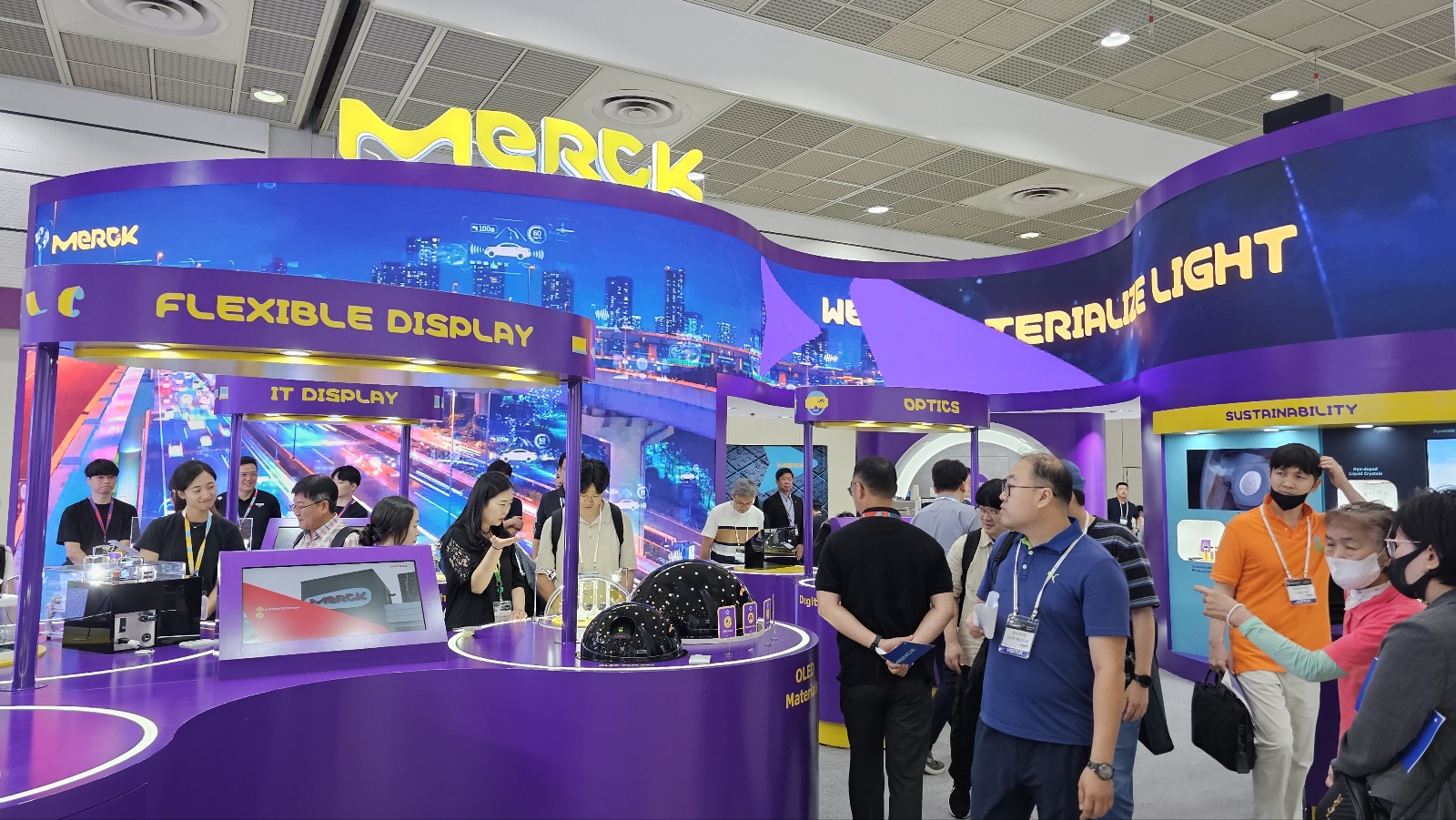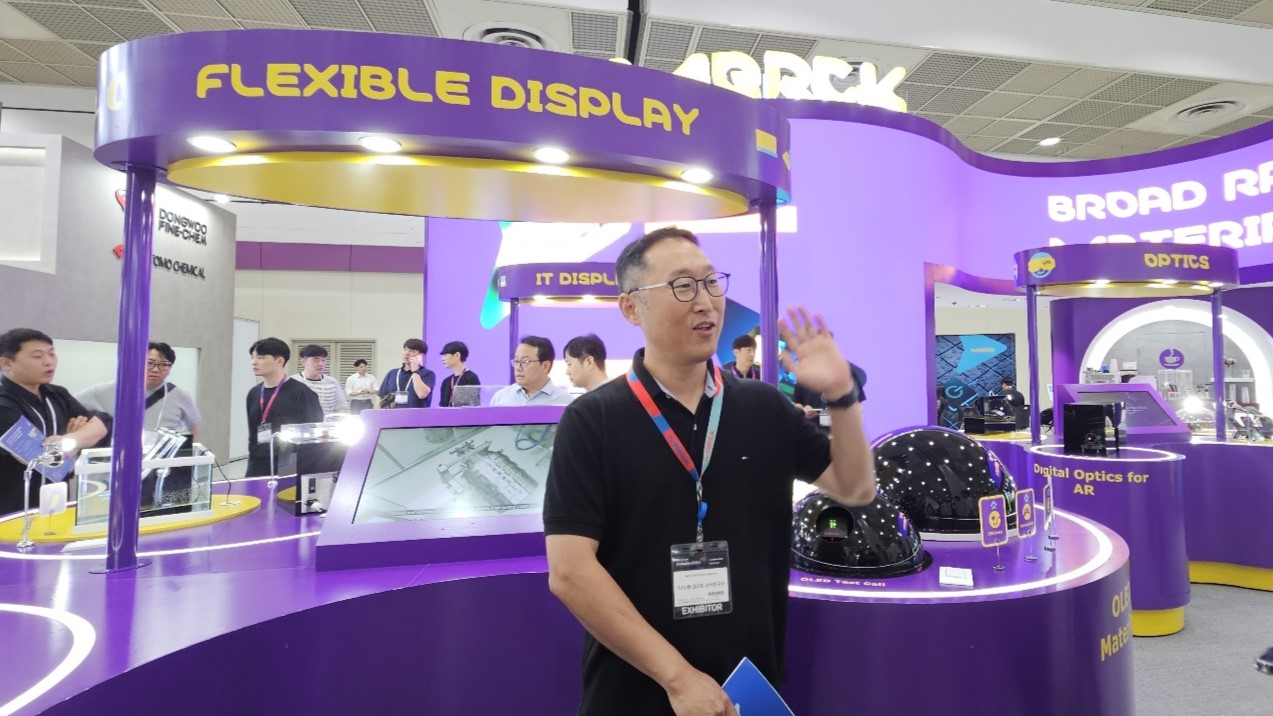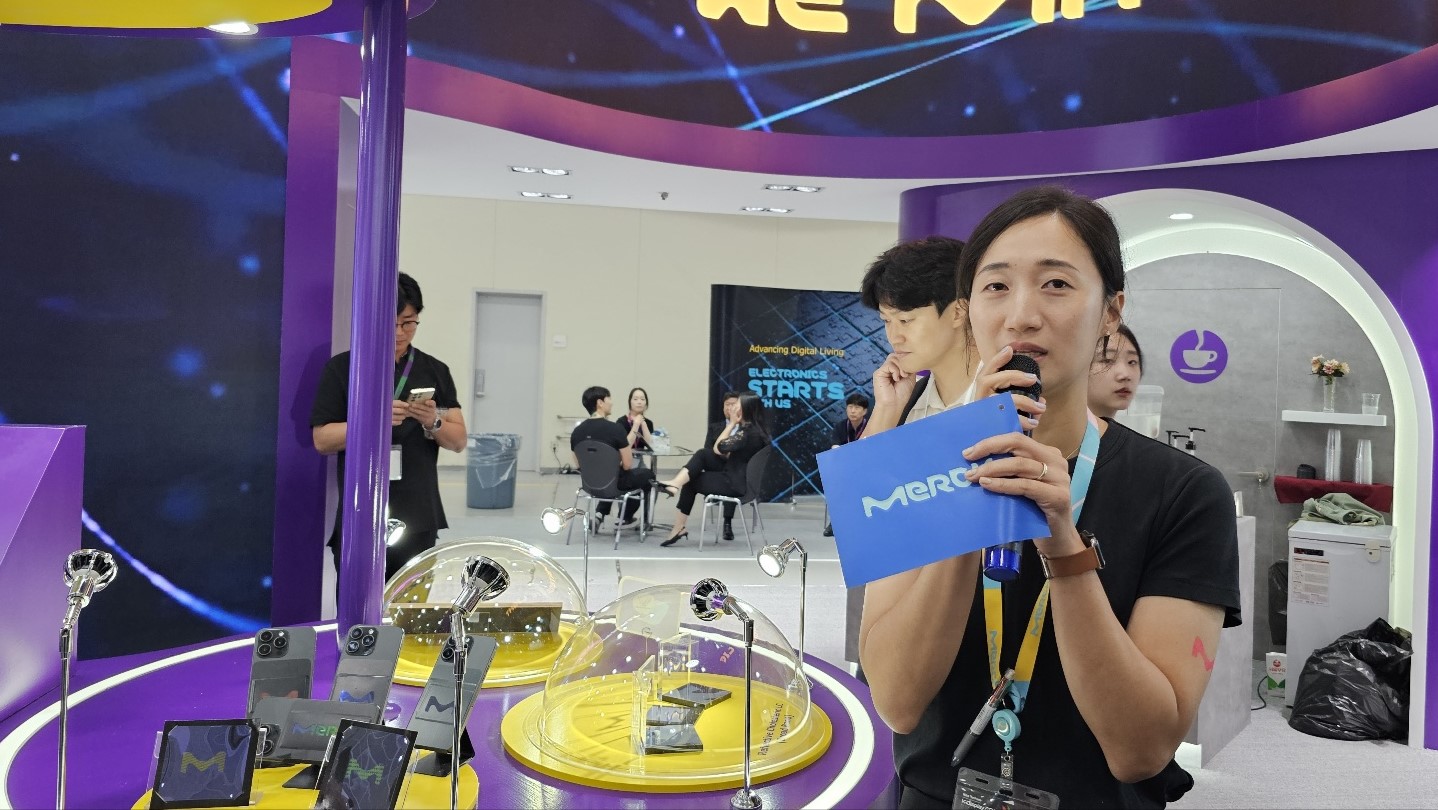디스플레이 기술은 데이터와 사용자 간의 커뮤니케이션 매개체로서 정보를 빛으로 구현하며 디바이스에 필수적인 기술로 자리매김했다. 이러한 빛의 기술에 혁신을 이끄는 머크의 재료 솔루션들이 대거 공개되며 눈길을 끌었다.

▲K-Display 2024 머크 부스 모습
최적화된 OLED 재료 솔루션·차세대 재료 솔루션 개발 박차
자동차용 디스플레이 미래, ‘머크 사이언스 커넥트’ 개최
디스플레이 기술은 데이터와 사용자 간의 커뮤니케이션 매개체로서 정보를 빛으로 구현하며 디바이스에 필수적인 기술로 자리매김했다. 이러한 빛의 기술에 혁신을 이끄는 머크의 재료 솔루션들이 대거 공개되며 눈길을 끌었다.
머크의 한국법인인 한국머크가 14일부터 사흘간 코엑스에서 열리는 국내 최대 디스플레이 전시회인 K-Display에 참가해 머크의 디스플레이 혁신 소재 인텔리전스(Materials Intelligence TM )를 선보였다.
머크는 ‘우리는 빛을 구현합니다’라는 슬로건 아래 △TV △IT △자동차 △AR/VR 분야에서 요구하는 디스플레이의 기술적 요구에 맞추어 소재를 개발해 왔다. 이번 전시회에서 △고휘도 △고투과도 △빠른 응답 속도 △고신뢰성 △저전력 △향상된 디바이스 수명 △최적화된 광학적 특성을 가지는 소재를 공개했다.
특히 올해는 △잉크젯 인쇄 가능한 저유전율 소재 △플렉시블 하드 코팅 소재 및 OLED 소재를 소개하는 플렉시블 디스플레이존 △LC & PR을 소개하는 프리미엄 디스플레이존 △지속 가능성 소재를 위한 존 △AR/VR에 사용되는 광학 소재를 소개하는 디지털 광학존까지 총 5개의 존에서 머크 전문가의 설명을 들을 수 있었다.
■ 최적화된 OLED 재료 솔루션

▲나수환 머크 수석연구원
이번 전시회 및 시장에 출시된 대부분의 OLED 제품들에 머크 재료가 탑재돼 있다고 자부하는 나수환 머크 OLED 수석연구원은 “최근 고객사에서는 태블릿용 애플리케이션에 집중하고 있는 상황이며 태블릿용 OLED는 투스택 탠덤(Two Stack Tandem) 구조를 채택해 싱글스택 대비 긴 수명, 2배 이상이 효율, 밝은 휘도 달성 등에 장점이 있다”고 설명했다.
이외에도 모니터, TV, 투명 디스플레이 및 게이밍 애플리케이션에서는 3중 스택 이상의 다중 구조가 개발되고 있다고 전했다.
머크는 OLED 테스트 셀 솔루션도 제공한다. 2020년 평택에 OLED 소재 및 LCD 테스트셀에 250억원 이상 투자한 바 있는 머크는 ‘마스터 트라이앵글’로 설정한 △전압 △효율 △수명 3가지 기준에서 트레이드 오프 관계를 최적화하기 위해 정공수송층 재료, 전자수송층 재료, 발광층 코스트 재료 등을 최적화해 고객사에 제공한다고 전했다.
나 수석은 “머크는 수명을 개선할 수 있는 중수소화 기술 개발에 집중해 오고 있다”면서 “경수소를 중수소로 대체하는 기술을 통해 EML에 사용되는 호스트 재료 및 전공수송층 재료 등에 적용하고 있다”고 말했다.
중수소는 경수소 대비 외부 자극에 반응성이 낮으며 청색 인광 호스트 재료 등에 적용돼 △수명 증가 △에너지 효율 향상 △밝기 증가 등의 이점을 주는 것으로 알려져 있다. 이러한 장점으로 차세대 OLED 재료로 중수소가 각광 받고 있다.
■ VR·AR·IT 디스플레이 재료 솔루션 총집합

▲박혜령 머크 책임연구원
머크는 VR을 위한 PB 렌즈 전시품을 공개했다. 박혜령 책임연구원은 “필름 1장으로 오목·볼록 렌즈 2장을 적용한 효과를 발휘하는 장점이 있다”면서 “이러한 기술을 VR에 적용하면 현실적인 입체감과 플라스틱 코팅 기반 가벼움을 선사할 수 있다”고 설명했다.
AR 솔루션에서는 PHV Grating 재료 기반 데모 제품을 선보였다. 박 책임은 “패턴화된 박막에 RM(반응성 메조겐)을 코팅해 회절을 조절할 수 있는 재료이다”라며 “웨이브 가이드 역할을 하는 필름으로써 다양한 색특성, 시야각, 광효율 등 다양한 광특성을 조절할 수 있다”고 말했다.
머크는 30년 이상의 RM 개발 경험과 노하우를 보유한 기업으로 차세대 디스플레이 애플리케이션 환경에 대응하는 개발에 박차를 가하고 있는 것으로 보인다.
권기선 연구팀장은 “최신 개발 제품으로는 높은 시인성을 위한 고투과율 액정향 재료를 개발하고 있으며, 높은 명암비를 위해 고탄성 액정을 개발하고 있다”면서 또한 저전력 저주파 구동 제품 제공과 플리커 현상을 해결하는 플리커 프리 제품 개발에 집중하고 있다고 전했다.
한국머크는 지난 35년간 액정과 OLED 분야에 지속적인 투자를 통해 국내 디스플레이 산업에서 디스플레이 산업의 미래 기술 트렌드를 가능하게 하는 소재 인텔리전스 (Material Intelligence TM )를 제공해왔으며, OLED 등 다양한 제품의 연구 및 개발을 현지화 했다.
한편, 머크는 AR/VR 비즈니스 헤드인 리처드 하딩박사가 ‘소형 폼 팩터, 완전 몰입형 AR 헤드셋을 향한 광학 재료의 최근 발전’ 이란 주제로 인사이트를 공유하고, 오는 20일부터 22일까지 제주 국제 컨벤션센터에서 트렌드 점검 및 인사이트를 공유하는 ‘머크 사이언스 커넥트(Merck Science Connect)’ 강연을 진행할 예정이다.
연사로는 옴디아 허무열 수석, 현대모비스 윤찬영 HUD광학셀장, 머크 김준호 한국 OLED 연구소장과 한양대학교 박진성 교수가 발표를 진행한다.


